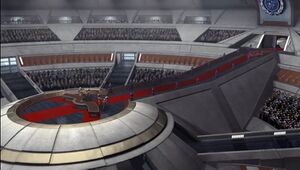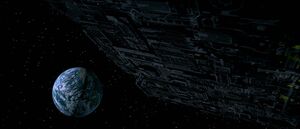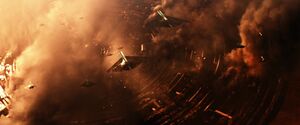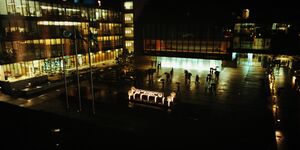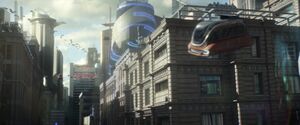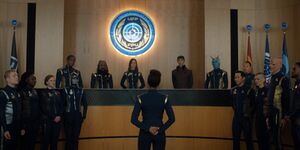Difference between revisions of "United Federation of Planets"
(HEAVILY a WIP) |
(Update for PIC S2 and 3) |
||
| (12 intermediate revisions by 4 users not shown) | |||
| Line 1: | Line 1: | ||
{{Icons|fed| | {{Icons|fed|bfc}}{{Government | ||
|name=United Federation of Planets | |name=United Federation of Planets | ||
|image=[[image:Federation.png]] | |image=[[image:Federation.png]] | ||
|species= | |species= | ||
* | *Humann | ||
* | *Vulcan | ||
* | *Andorian | ||
* | *Tellarite | ||
|homeworld= | |homeworld= | ||
* | *Earth | ||
* | *Andoria | ||
* | *Vulcan | ||
* | *Tellar Prime | ||
|founded=2161 CE | |founded=2161 CE | ||
|warp= | |warp= | ||
*Humans - 2063 CE | *Humans - 2063 CE | ||
*Vulcans -Before 850 BCE | *Vulcans - Before 850 BCE | ||
|language=Federation Standard (English) | |language=Federation Standard (English) | ||
|currency=Federation Credit | |currency=Federation Credit | ||
|government=Federal Republic | |government=Federal Republic | ||
|leader= | |leader= | ||
* | *President of the Federation | ||
* | *Federation Council | ||
* | *Federation Supreme Court | ||
* | *Starfleet Command | ||
|military=[[Starfleet]] | |military=[[Starfleet]] | ||
}}The United Federation of Planets ( | }}The '''United Federation of Planets''' (also known as the '''UFP''' or the '''Federation''') is a union of interstellar powers, planets, and peoples, operating under a democratic central government. It is committed to principles of peace and cooperation, coming together for scientific development, mutual aid, and military protection. | ||
==Size and Location== | ==Size and Location== | ||
The Federation stretches across the [[:Category:Alpha Quadrant|Alpha Quadrant]] and the [[:Category:Beta Quadrant|Beta Quadrant]]; it speaks of the Federation's power that '''Sol''' is considered the 'border' between the two. By the 2390s, the power's territory has spread to over 8,000 light-years with over a thousand semi-autonomous colonies and over 150 members. Most of those members are distinct species and cultures united under the Federation's government and principles, though powerful early colonies may have established themselves as individual members with separate, distinct interests. Because of this size, the Federation shares a border with every major power of both quadrants, as well as many of the lesser powers. | |||
==History== | |||
[[File:Federation founding.jpg|left|thumb|The founding of the Federation, 2161]] | |||
The Federation was founded in San Francisco, Earth, in 2161. This was the result of ten years of cooperation and diplomacy between the founding worlds of Earth, Andoria, Vulcan, and Tellar Prime, largely prompted by the entrance of the diplomatic humans to the interstellar stage. Less harmoniously, the United Earth had recently emerged from a long war with the [[Old Romulan Star Empire]], which had only ended with the assistance of the other races, and all powers were in relative proximity to the belligerent [[Klingon Empire]]. The fledgling Federation was thus motivated by mutual defence as much as cooperation in science and economics. | |||
These and other powers would challenge the ascendant Federation in the coming decades and centuries. Expansion brought in more worlds and more territory, and this naturally brought them into conflict with galactic powers who did not share their principles of cooperation. Most notable have been multiple conflicts with the Klingon Empire in the 23rd century, the long cold war with the Romulans, and decades of intermittent violence with the [[Cardassian Union]] in the 24th century. But far longer were eras of peaceful exploration and diplomacy, and the Federation defined itself and Starfleet by those principles for two hundred years. | |||
[[File:Borgearth.jpg|thumb|A Borg cube on course for Earth]] | |||
The first blow came in 2365, the first encounter with the [[ma:Borg|Borg]]. One of the most destructive forces in the galaxy, the Borg [[ma:Battle of Wolf 359|invaded]] the Federation [[ma:Battle of Sector 001|twice]] in less than a decade. This unknowable, incomprehensible threat from outside of known space struck a deep fear into the Federation; finally they had met an enemy who could not be reasoned with through peace, as had been achieved even with the warrior Klingons. While the militarisation of Starfleet that followed was only for a small, specialist force, never before had the Federation prepared weapons for an enemy they could only ever respond to with violence. | |||
In many ways, the Borg threat better prepared the Federation for the [[ma:Dominion War|Dominion War]]. Diplomacy was attempted when first the Federation entered the [[:Category:Gamma Quadrant|Gamma Quadrant]], but soon the Dominion joined forces with the Cardassian Union and sought to conquer the Alpha Quadrant. The Federation was equipped for warfare, psychologically and militarily, better than it might have been ten years prior, but victory was achieved primarily through an alliance with the Klingons and the Romulans. It still came at a high cost, with many member worlds experiencing periods of Dominion occupation, and a strike on Earth by the [[Breen Confederacy|Breen]] devastating San Francisco. | |||
The aftermath saw the Federation committed to robust cooperation with its new allies and even its old enemies, sending aid to rebuild the Cardassian Union. Diplomatic intervention was at its highest, the Federation committed to maintaining the balance of power through its new in-roads and positive relations. While the impending [[ma:Romulan Supernova|supernova of the Romulan sun]] was unprecedented, so was the Romulan Star Empire's request for aid in evacuating its citizens in time, a reflection of this age of cooperation. | |||
But this cooperation had come at a price. Member worlds were wary of how the Federation's expansion and Starfleet's ventures had exposed them to new threats, such as the Borg and the Dominion, which would never have been found without such deep space exploration. Some thought the Romulans had joined the Dominion War too late, allowing thousands to perish and multiple worlds to fall under Jem'hadar rule, and only joining when their own interests were finally threatened. This buoyed up old resentments and self-interests, and 14 members issued objections to the vast dedication of resources and redirection of border defences the evacuation necessitated. | |||
[[File:Attackonmars.jpg|left|thumb|The attack on Mars]] | |||
This did not stop the evacuation. But on First Contact Day of 2385, the network of synthetic workers on Mars [[ma:Attack on Mars|suddenly turned on the workers and populace]], committing mass slaughter and destruction. Over 90,000 casualties were sustained, the evacuation fleet was destroyed, and the atmosphere of Mars remains ablaze as of 2399. Not only was the evacuation abandoned, but the Federation Council placed a ban on creating or researching artificial life. All policy after focused upon maintaining the interests and protection of member worlds. | |||
The Federation withdrew many of its expensive aid programmes, such as the rebuilding of Cardassia, and reduced its diplomatic involvement in other powers beyond maintaining peace and stability. Starfleet became dedicated far more to protecting Federation territory, the populace leery of exploratory missions which might draw the attention of a new Borg or a new Dominion. In practice, member worlds' needs and protection were prioritised, leading to occasional hardship for colonies and border planets. | |||
In mid-2399, the Federation was shaken by the discovery of the role of the [[ma:Tal Shiar|Tal Shiar]] in the Attack on Mars. Relations with the [[Romulan Free State]] have since cooled, and the ban on synthetic lifeforms has been lifted. | |||
=== 25th Century === | |||
After the truth of the Attack on Mars was discovered, the Federation wrestled with the isolationist policies that had come out of the disaster and entered a period of reform, seeking to return to its traditional values. Diplomatic outreach began anew both at home and abroad, with relationships built with neighbouring states and more resources funnelled to border worlds. This was not a change without controversy, many of the conservative voices who had rallied against causes such as helping the Romulan evacuation resisting anything they saw as compromising the security of member states, but at the dawn of the 25th century, the progressive causes hold dominance in Federation policy. | |||
It will take some time for the Federation to restore both its credibility and foothold in fields both interstellar and domestic. Ties between core and border worlds in particular are weak, with many of these regions left to be self-sufficient for some fifteen years. In interstellar matters, other governments have grown accustomed to acting without Federation involvement, and are slow to recognise their authority. The Federation has to prove itself consistent and demonstrate its change of heart is here to stay in order to restore its previous place on the interstellar stage. | |||
The calamity of [[ma:Frontier Day|Frontier Day]] brought fresh chaos to the Federation, especially Starfleet. While the government is rebuilding and citizens recovering, resilient and refusing to let this have the same impact on them as Mars, Starfleet's capacity to enact this policy of involvement and optimism has been hampered. Only time will tell how strong the Federation's future may be. | |||
==Government== | ==Government== | ||
The government consists of three branches: the executive, the legislature and the judiciary. | [[File:Federationpalais.jpg|thumb|Paris, Earth, is the heart of the Federation's government]] | ||
The government consists of three branches: the executive, the legislature and the judiciary. Their responsibilities are laid out in the Constitution of the United Federation of Planets. The head of state and government is the Federation President, a democratically elected official who oversees most of the Federation's foreign policy and economy, and acts as supreme commander of the Federation's forces. They are aided by the Federation Cabinet, an advisory body and the leaders of the Federation's extensive government departments. The executive is based out of the Palais de la Concorde in Paris, Earth. | |||
The Federation Council is the legislative body, containing representatives of every member world. The Council has the power to create and amend Federation law, and their meeting chambers are in San Francisco, Earth. Finally, the judiciary consists of a hierarchy of courts, headed by the Federation Supreme Court. | |||
The Federation Council is the | |||
=== | ===Membership=== | ||
New member worlds may petition for membership and join if successful, or be invited. Eligibility for either requires the world to be sufficiently advanced, usually defined as enough to join the galactic community, such as developing faster-than-light travel or, sometimes, communication. The world must also have a single, stable, planetary government that respects the rights of the individual and diversity of political and social beliefs. | |||
Those petitioning must submit this petition to the Federation Council, which leads to an extensive investigation of their culture. This scrutiny often includes unfettered access to government and public records to ascertain if the culture genuinely shares the values of the Federation, and may take several years. However, the Federation commits to an admittance process including a timetable, holding itself accountable to not stymie the development of a culture by entrenching them in bureaucracy, however essential it may be that the process is thorough. | |||
=== | |||
==== Colonies ==== | |||
Member worlds often join the Federation as the centers of interplanetary states themselves. Colonies settled by member worlds are part of the Federation but not themselves separate Federation members with independent representation on the Federation Council. The Federation does ensure, however, that the same standards of democracy, liberty, representation, and self-determination are met when regulating the relationships between members and their colonies. Colonies are led by Governors, who may initially be appointed by the founding world but must eventually be elected by the citizens of the world they govern. | |||
The Federation | |||
The right of colonies to elect for self-governance is enshrined in the Constitution, and many worlds do eventually separate themselves from their founding state. Eventually, full membership may be attained when certain benchmarks (such as population, development, economic output) have been achieved. Colonies may also be founded under a direct charter through the Federation itself, not subject to the laws of any member world but also not yet member world themselves. Self-governing colonies are led by Governors-General, who are elected by their citizens. | |||
==Society== | |||
[[File:Fedcity.jpg|thumb|All Federation citizens enjoy a comfortable standard of living]] | |||
The Federation has no internal currency; due to their principles and sharing of resources, all citizens enjoy a comfortable standard of living. Their ideology of cooperation motivates them rather than material gain out of greed or a need for survival and comfort, encouraging citizens to pursue their own interests and to contribute to the wellbeing of themselves, others, and society as a whole. As such, artists and scholars may pursue their work or knowledge freely, without needing to produce marketable goods or acquire patronage or funding. While everyone is encouraged to attain their potential wherever it may be, society thinks particularly highly of those who dedicate themselves to helping others, be it through community service or advancing knowledge. | |||
The Constitution includes what are referred to as the Guarantees. These enshrine the rights to which the Federation believes all sentient beings are entitled. More than a matter of law, this document enforces and represents the ethics of the Federation and its citizens. They remain as a whole committed to treating all life with dignity, to sharing what they have, and to collectively uplifting one another. | |||
However, the Federation is made up of scores, if not hundreds of species. While being members of the Federation commits them to these principles, and they do so willingly, there is always variety and diversity among the cultures and perspectives of the Federation. This is considered a strength, rather than a weakness, as the Federation value the ways in which they are different as much as they have found common cause. It can make dealing with the Federation unpredictable on an individual basis; a Vulcan will treat very differently to a Tellarite, for instance. But this diversity speaks more of ''how'' a Federation citizen or representative may pursue their goals; those goals will universally be tempered by a culture committed to cooperation, knowledge, and peace. | |||
All of this has took blows over the last thirty years. Repeated invasions by the Borg and the Dominion, and most notably the synth attack on Mars, left Federation citizens feeling vulnerable to outside threat and paranoid of where they might come from. While there has been far from a breakdown of society or the culture of mutual aid and cooperation, Federation citizens are at their most paranoid and self-interested, far more likely to only help their immediate neighbour than reach out to a stranger. This mentality has seen a shift with the start of the new century and the discovery that Mars was a manipulation, with Federation citizens recognising they were wrong to blame synths as they did. Progressive voices advocating the more high-minded Federation values are currently in ascent, but cultural change will not come overnight. | |||
==Military== | |||
[[File:Starfleetcommand1.jpg|left|thumb|Starfleet has represented the Federation's interests since its founding]] | |||
The most formal militarised bodies of the Federation are those of individual member worlds. These usually originated in the navies from before their membership, and tend to retain those unique cultures and practices. Each member world maintains its own routine protection with these forces, with production of ships and weapons often supplemented by old Starfleet vessels. In practice, they contend with security threats such as pirates and lend aid to local travellers who might be in distress. In case of sudden attack they are the most immediate and easily-rallied defence. However, they are exactly that: defence, and do not participate in operations beyond their jurisdictions. | |||
Defence for the Federation as a whole and against serious threats comes from Starfleet. Starfleet is primarily a scientific organisation, dedicated to peaceful exploration. The dangers of the wider galaxy, which have been especially prevalent over the last thirty years, necessitate Starfleet ships to be armed and for their crews to be trained and ready for danger. The crews are highly cohesive and exceptionally well-trained, and Starfleet ships are at the cutting edge of technology for the Alpha and Beta Quadrants. Captains are, however, taught to attempt all peaceful resolutions before resorting to violence. While the culture of diplomacy has been undermined by thirty years of existential threat, Starfleet practice has not formally wavered. | |||
==In Play== | |||
*The Federation is, at its heart, about mutual cooperation, embracing diversity of culture and idea, and seeking peace and friendship with anyone it encounters. Those who treat with them in good faith will be received with enthusiastic diplomacy, and those who do not will receive every effort to bring them to the table. Violence is a last resort and always in the name of defence rather than resources or opportunity. | |||
*The Federation is a post-scarcity economy, and an egalitarian society with robust practices to protect individual and group rights. Individual citizens may be motivated by hate or greed or selfishness; they are people, after all. But they are not as a rule subject to the systemic legal, social, or economic pressures that drive modern-day crime or discrimination. | |||
*For the past fifteen years, however, the trauma experienced by the Federation from the Borg invasions, the Dominion War, and the Attack on Mars were dominant in the cultural and political psyche. The Federation spent that time being paranoid and reclusive, stopping large humanitarian efforts, major scientific missions beyond its borders, or involving itself in interstellar politics. While this has begun to change, that transformation cannot take place overnight. | |||
*This can be seen most of all at the fringes of the Federation. Border worlds and minor colonies are the last to receive economic support or Starfleet protection unless they are important strategically. Faith in the Federation there is recovering, but only slowly, and Starfleet ships in such regions may face uncooperative locals who often need but will not ask for or accept their help. This is where foreign powers or criminal factions have exploited the Federation's insular practices while the Core Worlds look away, and these regions are the most deprived and dangerous in the Federation. | |||
=External Information= | |||
*[https://memory-alpha.fandom.com/wiki/United_Federation_of_Planets United Federation of Planets] at Memory Alpha | |||
[[Category:Alpha Quadrant]] | |||
[[Category:Beta Quadrant]] | |||
Latest revision as of 12:16, 17 December 2023

| |
| United Federation of Planets | |
| Basic Information | |
| Major Species |
|
| Homeworld(s) |
|
| Founded |
2161 CE |
| Warp Capable |
|
| Official Language |
Federation Standard (English) |
| Official Currency |
Federation Credit |
| Political Information | |
| Governance Type |
Federal Republic |
| Leader |
|
| Military Branches | |
| Template:Government | |
The United Federation of Planets (also known as the UFP or the Federation) is a union of interstellar powers, planets, and peoples, operating under a democratic central government. It is committed to principles of peace and cooperation, coming together for scientific development, mutual aid, and military protection.
Size and Location
The Federation stretches across the Alpha Quadrant and the Beta Quadrant; it speaks of the Federation's power that Sol is considered the 'border' between the two. By the 2390s, the power's territory has spread to over 8,000 light-years with over a thousand semi-autonomous colonies and over 150 members. Most of those members are distinct species and cultures united under the Federation's government and principles, though powerful early colonies may have established themselves as individual members with separate, distinct interests. Because of this size, the Federation shares a border with every major power of both quadrants, as well as many of the lesser powers.
History
The Federation was founded in San Francisco, Earth, in 2161. This was the result of ten years of cooperation and diplomacy between the founding worlds of Earth, Andoria, Vulcan, and Tellar Prime, largely prompted by the entrance of the diplomatic humans to the interstellar stage. Less harmoniously, the United Earth had recently emerged from a long war with the Old Romulan Star Empire, which had only ended with the assistance of the other races, and all powers were in relative proximity to the belligerent Klingon Empire. The fledgling Federation was thus motivated by mutual defence as much as cooperation in science and economics.
These and other powers would challenge the ascendant Federation in the coming decades and centuries. Expansion brought in more worlds and more territory, and this naturally brought them into conflict with galactic powers who did not share their principles of cooperation. Most notable have been multiple conflicts with the Klingon Empire in the 23rd century, the long cold war with the Romulans, and decades of intermittent violence with the Cardassian Union in the 24th century. But far longer were eras of peaceful exploration and diplomacy, and the Federation defined itself and Starfleet by those principles for two hundred years.
The first blow came in 2365, the first encounter with the Borg. One of the most destructive forces in the galaxy, the Borg invaded the Federation twice in less than a decade. This unknowable, incomprehensible threat from outside of known space struck a deep fear into the Federation; finally they had met an enemy who could not be reasoned with through peace, as had been achieved even with the warrior Klingons. While the militarisation of Starfleet that followed was only for a small, specialist force, never before had the Federation prepared weapons for an enemy they could only ever respond to with violence.
In many ways, the Borg threat better prepared the Federation for the Dominion War. Diplomacy was attempted when first the Federation entered the Gamma Quadrant, but soon the Dominion joined forces with the Cardassian Union and sought to conquer the Alpha Quadrant. The Federation was equipped for warfare, psychologically and militarily, better than it might have been ten years prior, but victory was achieved primarily through an alliance with the Klingons and the Romulans. It still came at a high cost, with many member worlds experiencing periods of Dominion occupation, and a strike on Earth by the Breen devastating San Francisco.
The aftermath saw the Federation committed to robust cooperation with its new allies and even its old enemies, sending aid to rebuild the Cardassian Union. Diplomatic intervention was at its highest, the Federation committed to maintaining the balance of power through its new in-roads and positive relations. While the impending supernova of the Romulan sun was unprecedented, so was the Romulan Star Empire's request for aid in evacuating its citizens in time, a reflection of this age of cooperation.
But this cooperation had come at a price. Member worlds were wary of how the Federation's expansion and Starfleet's ventures had exposed them to new threats, such as the Borg and the Dominion, which would never have been found without such deep space exploration. Some thought the Romulans had joined the Dominion War too late, allowing thousands to perish and multiple worlds to fall under Jem'hadar rule, and only joining when their own interests were finally threatened. This buoyed up old resentments and self-interests, and 14 members issued objections to the vast dedication of resources and redirection of border defences the evacuation necessitated.
This did not stop the evacuation. But on First Contact Day of 2385, the network of synthetic workers on Mars suddenly turned on the workers and populace, committing mass slaughter and destruction. Over 90,000 casualties were sustained, the evacuation fleet was destroyed, and the atmosphere of Mars remains ablaze as of 2399. Not only was the evacuation abandoned, but the Federation Council placed a ban on creating or researching artificial life. All policy after focused upon maintaining the interests and protection of member worlds.
The Federation withdrew many of its expensive aid programmes, such as the rebuilding of Cardassia, and reduced its diplomatic involvement in other powers beyond maintaining peace and stability. Starfleet became dedicated far more to protecting Federation territory, the populace leery of exploratory missions which might draw the attention of a new Borg or a new Dominion. In practice, member worlds' needs and protection were prioritised, leading to occasional hardship for colonies and border planets.
In mid-2399, the Federation was shaken by the discovery of the role of the Tal Shiar in the Attack on Mars. Relations with the Romulan Free State have since cooled, and the ban on synthetic lifeforms has been lifted.
25th Century
After the truth of the Attack on Mars was discovered, the Federation wrestled with the isolationist policies that had come out of the disaster and entered a period of reform, seeking to return to its traditional values. Diplomatic outreach began anew both at home and abroad, with relationships built with neighbouring states and more resources funnelled to border worlds. This was not a change without controversy, many of the conservative voices who had rallied against causes such as helping the Romulan evacuation resisting anything they saw as compromising the security of member states, but at the dawn of the 25th century, the progressive causes hold dominance in Federation policy.
It will take some time for the Federation to restore both its credibility and foothold in fields both interstellar and domestic. Ties between core and border worlds in particular are weak, with many of these regions left to be self-sufficient for some fifteen years. In interstellar matters, other governments have grown accustomed to acting without Federation involvement, and are slow to recognise their authority. The Federation has to prove itself consistent and demonstrate its change of heart is here to stay in order to restore its previous place on the interstellar stage.
The calamity of Frontier Day brought fresh chaos to the Federation, especially Starfleet. While the government is rebuilding and citizens recovering, resilient and refusing to let this have the same impact on them as Mars, Starfleet's capacity to enact this policy of involvement and optimism has been hampered. Only time will tell how strong the Federation's future may be.
Government
The government consists of three branches: the executive, the legislature and the judiciary. Their responsibilities are laid out in the Constitution of the United Federation of Planets. The head of state and government is the Federation President, a democratically elected official who oversees most of the Federation's foreign policy and economy, and acts as supreme commander of the Federation's forces. They are aided by the Federation Cabinet, an advisory body and the leaders of the Federation's extensive government departments. The executive is based out of the Palais de la Concorde in Paris, Earth.
The Federation Council is the legislative body, containing representatives of every member world. The Council has the power to create and amend Federation law, and their meeting chambers are in San Francisco, Earth. Finally, the judiciary consists of a hierarchy of courts, headed by the Federation Supreme Court.
Membership
New member worlds may petition for membership and join if successful, or be invited. Eligibility for either requires the world to be sufficiently advanced, usually defined as enough to join the galactic community, such as developing faster-than-light travel or, sometimes, communication. The world must also have a single, stable, planetary government that respects the rights of the individual and diversity of political and social beliefs.
Those petitioning must submit this petition to the Federation Council, which leads to an extensive investigation of their culture. This scrutiny often includes unfettered access to government and public records to ascertain if the culture genuinely shares the values of the Federation, and may take several years. However, the Federation commits to an admittance process including a timetable, holding itself accountable to not stymie the development of a culture by entrenching them in bureaucracy, however essential it may be that the process is thorough.
Colonies
Member worlds often join the Federation as the centers of interplanetary states themselves. Colonies settled by member worlds are part of the Federation but not themselves separate Federation members with independent representation on the Federation Council. The Federation does ensure, however, that the same standards of democracy, liberty, representation, and self-determination are met when regulating the relationships between members and their colonies. Colonies are led by Governors, who may initially be appointed by the founding world but must eventually be elected by the citizens of the world they govern.
The right of colonies to elect for self-governance is enshrined in the Constitution, and many worlds do eventually separate themselves from their founding state. Eventually, full membership may be attained when certain benchmarks (such as population, development, economic output) have been achieved. Colonies may also be founded under a direct charter through the Federation itself, not subject to the laws of any member world but also not yet member world themselves. Self-governing colonies are led by Governors-General, who are elected by their citizens.
Society
The Federation has no internal currency; due to their principles and sharing of resources, all citizens enjoy a comfortable standard of living. Their ideology of cooperation motivates them rather than material gain out of greed or a need for survival and comfort, encouraging citizens to pursue their own interests and to contribute to the wellbeing of themselves, others, and society as a whole. As such, artists and scholars may pursue their work or knowledge freely, without needing to produce marketable goods or acquire patronage or funding. While everyone is encouraged to attain their potential wherever it may be, society thinks particularly highly of those who dedicate themselves to helping others, be it through community service or advancing knowledge.
The Constitution includes what are referred to as the Guarantees. These enshrine the rights to which the Federation believes all sentient beings are entitled. More than a matter of law, this document enforces and represents the ethics of the Federation and its citizens. They remain as a whole committed to treating all life with dignity, to sharing what they have, and to collectively uplifting one another.
However, the Federation is made up of scores, if not hundreds of species. While being members of the Federation commits them to these principles, and they do so willingly, there is always variety and diversity among the cultures and perspectives of the Federation. This is considered a strength, rather than a weakness, as the Federation value the ways in which they are different as much as they have found common cause. It can make dealing with the Federation unpredictable on an individual basis; a Vulcan will treat very differently to a Tellarite, for instance. But this diversity speaks more of how a Federation citizen or representative may pursue their goals; those goals will universally be tempered by a culture committed to cooperation, knowledge, and peace.
All of this has took blows over the last thirty years. Repeated invasions by the Borg and the Dominion, and most notably the synth attack on Mars, left Federation citizens feeling vulnerable to outside threat and paranoid of where they might come from. While there has been far from a breakdown of society or the culture of mutual aid and cooperation, Federation citizens are at their most paranoid and self-interested, far more likely to only help their immediate neighbour than reach out to a stranger. This mentality has seen a shift with the start of the new century and the discovery that Mars was a manipulation, with Federation citizens recognising they were wrong to blame synths as they did. Progressive voices advocating the more high-minded Federation values are currently in ascent, but cultural change will not come overnight.
Military
The most formal militarised bodies of the Federation are those of individual member worlds. These usually originated in the navies from before their membership, and tend to retain those unique cultures and practices. Each member world maintains its own routine protection with these forces, with production of ships and weapons often supplemented by old Starfleet vessels. In practice, they contend with security threats such as pirates and lend aid to local travellers who might be in distress. In case of sudden attack they are the most immediate and easily-rallied defence. However, they are exactly that: defence, and do not participate in operations beyond their jurisdictions.
Defence for the Federation as a whole and against serious threats comes from Starfleet. Starfleet is primarily a scientific organisation, dedicated to peaceful exploration. The dangers of the wider galaxy, which have been especially prevalent over the last thirty years, necessitate Starfleet ships to be armed and for their crews to be trained and ready for danger. The crews are highly cohesive and exceptionally well-trained, and Starfleet ships are at the cutting edge of technology for the Alpha and Beta Quadrants. Captains are, however, taught to attempt all peaceful resolutions before resorting to violence. While the culture of diplomacy has been undermined by thirty years of existential threat, Starfleet practice has not formally wavered.
In Play
- The Federation is, at its heart, about mutual cooperation, embracing diversity of culture and idea, and seeking peace and friendship with anyone it encounters. Those who treat with them in good faith will be received with enthusiastic diplomacy, and those who do not will receive every effort to bring them to the table. Violence is a last resort and always in the name of defence rather than resources or opportunity.
- The Federation is a post-scarcity economy, and an egalitarian society with robust practices to protect individual and group rights. Individual citizens may be motivated by hate or greed or selfishness; they are people, after all. But they are not as a rule subject to the systemic legal, social, or economic pressures that drive modern-day crime or discrimination.
- For the past fifteen years, however, the trauma experienced by the Federation from the Borg invasions, the Dominion War, and the Attack on Mars were dominant in the cultural and political psyche. The Federation spent that time being paranoid and reclusive, stopping large humanitarian efforts, major scientific missions beyond its borders, or involving itself in interstellar politics. While this has begun to change, that transformation cannot take place overnight.
- This can be seen most of all at the fringes of the Federation. Border worlds and minor colonies are the last to receive economic support or Starfleet protection unless they are important strategically. Faith in the Federation there is recovering, but only slowly, and Starfleet ships in such regions may face uncooperative locals who often need but will not ask for or accept their help. This is where foreign powers or criminal factions have exploited the Federation's insular practices while the Core Worlds look away, and these regions are the most deprived and dangerous in the Federation.
External Information
- United Federation of Planets at Memory Alpha
